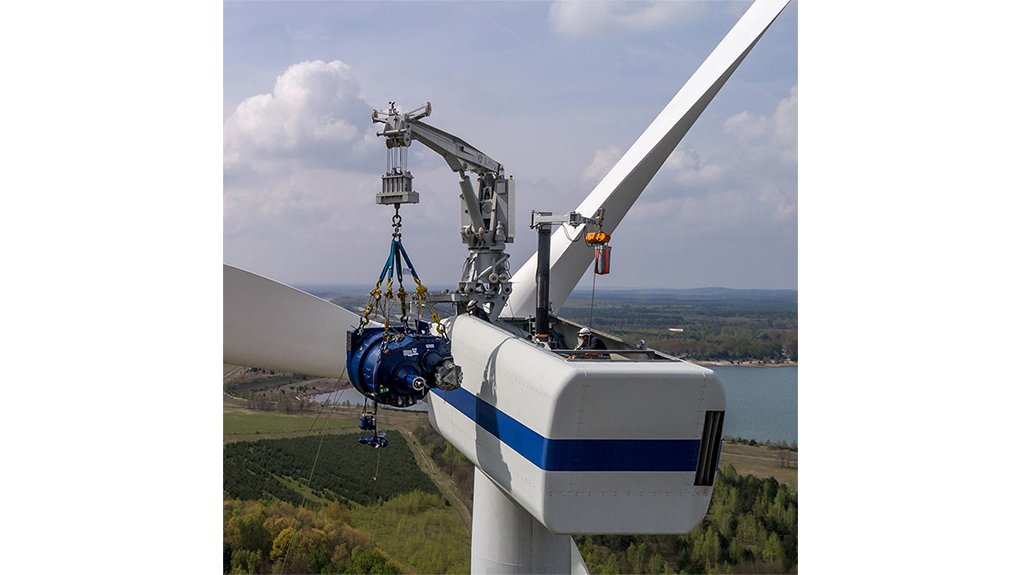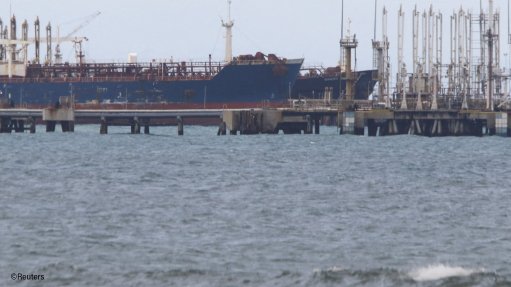Crane-less technology simplifies turbine repair


CRANE-LESS SOLUTION Crane-less technology mitigates the need for large ground-operated cranes for maintenance purposes
Given the increasing size and weight of wind turbine components, ‘crane-less technology’ is becoming more relevant in the wind energy sector and will likely be adopted more widely in South Africa in the coming years, says power plant operator 3Energy CEO Florian Kroeber.
While the term crane-less is used in the wind energy industry, it is misleading because most systems still use equipment that comprises a crane, although this technology mitigates the need for large ground-operated cranes for maintenance purposes.
Previously, turbines installed had hub heights of 80 m to 100 m, and a maximum power output of 2 MW to 3 MW; new turbines installed have hub heights of 100 m to 140 m, and power output exceeding 5 MW. As a result, they are more efficient, cost-effective and more powerful, he explains.
However, the weight of every individual component has increased accordingly, and the components must be lifted higher for installation and exchange, with an increase in the geographic spread of new wind-farm installations across the country.
Therefore, to make these installations and repairs possible, larger cranes are required and they must be transported over increasingly longer distances.
Further, compared to other regions worldwide, the use of big ground-operated cranes is more costly in South Africa because of the distances that have to be covered between wind farms. Further, truck drivers need to navigate poor road infrastructure.
“It will always make sense to mobilise crane capacity for the construction of an entire wind farm, but it does not make sense to bring in a big ground-operated crane for the exchange or repair of one individual component,” says Kroeber.
Therefore, using crane-less solutions, which use the existing wind turbine structure to support lifting equipment, such as hoists, booms and jibs, is becoming more feasible. The lifting equipment is mounted either onto the tower or nacelle of the wind turbine structure.
“The equipment can then be used to lift and lower main components, such as the individual blades, full star, main shaft, gearbox and generator,” Kroeber explains.
Heavy Lifting
For most crane-less solutions, the crane modules are hoisted up and assembled up-tower.
Kroeber says the equipment required for crane-less solutions depends on the component that must be lowered from the nacelle to ground level and the lifting solution applied.
A common use of ground-operated cranes is to lower and lift individual blades for down-tower repairs, but this can easily be replaced by a crane-less solution, he notes.
With a crane-less solution, the blade in question is hoisted down in the ‘six o’clock position’. Hoists are mounted in the hub, and a smaller crane assists in bringing the blade into a horizontal position. This process enables wind farm operators to conduct more blade repairs down tower, and significantly reduces repair time.
He adds that some suppliers are experimenting with a solution whereby the crane lifts itself up from outside of the tower and while this seems compelling, it is more likely that the industry will adopt technologies that must be assembled up-tower and mounted to the nacelle structure.
Kroeber says South African wind turbine operators have a strong incentive to look for alternative solutions to big ground-operated cranes, especially for the repair and exchange of components.
Big cranes that operate from ground level are difficult to move on public roads, owing to their size and weight and, consequently, it requires multiple trucks to transport the auxiliary equipment and structures. As a result, the mobilisation costs and times are significant.
Further, the initial investment associated with buying a ground-operated crane is significant, which is compounded by the uncertainty of whether the crane design will be relevant over a long period.
Therefore, owners of such cranes will try to amortise the initial cost over a short period, resulting in crane rental costs being “very high”.
However, crane-less solutions are cheaper from an initial investment perspective, and are easier to transport, says Kroeber.
The components required for a crane-less solution can fit on one standard size truck and can be moved without special permits and, if hub heights increase, the crane will not become irrelevant, making the solution more flexible and cost effective in the longer term.
Crane-less technology is relatively new, but a few early-adaptor markets have already started to use this technology, he adds.
Reaching New Heights
As the demand for energy increases, many countries, including South Africa, are turning to renewable energy to simultaneously address the need for clean energy. Wind, along with solar, represents most of the new-generation capacity installed in the past ten years and will continue to grow in the foreseeable future, says Kroeber.
He explains that wind and solar power are viewed as more accessible renewable power sources, largely owing to investors’ ability to finance those technologies, the attractive cost of electricity, mature technology and ease of installation and operation.
Emerging offtake models, such as commercial and industrial power purchase agreements, will further accelerate the rate of installation and increase the geographical speed of new installations, he concludes.
Article Enquiry
Email Article
Save Article
Feedback
To advertise email advertising@creamermedia.co.za or click here
Comments
Announcements
What's On
Subscribe to improve your user experience...
Option 1 (equivalent of R125 a month):
Receive a weekly copy of Creamer Media's Engineering News & Mining Weekly magazine
(print copy for those in South Africa and e-magazine for those outside of South Africa)
Receive daily email newsletters
Access to full search results
Access archive of magazine back copies
Access to Projects in Progress
Access to ONE Research Report of your choice in PDF format
Option 2 (equivalent of R375 a month):
All benefits from Option 1
PLUS
Access to Creamer Media's Research Channel Africa for ALL Research Reports, in PDF format, on various industrial and mining sectors
including Electricity; Water; Energy Transition; Hydrogen; Roads, Rail and Ports; Coal; Gold; Platinum; Battery Metals; etc.
Already a subscriber?
Forgotten your password?
Receive weekly copy of Creamer Media's Engineering News & Mining Weekly magazine (print copy for those in South Africa and e-magazine for those outside of South Africa)
➕
Recieve daily email newsletters
➕
Access to full search results
➕
Access archive of magazine back copies
➕
Access to Projects in Progress
➕
Access to ONE Research Report of your choice in PDF format
RESEARCH CHANNEL AFRICA
R4500 (equivalent of R375 a month)
SUBSCRIBEAll benefits from Option 1
➕
Access to Creamer Media's Research Channel Africa for ALL Research Reports on various industrial and mining sectors, in PDF format, including on:
Electricity
➕
Water
➕
Energy Transition
➕
Hydrogen
➕
Roads, Rail and Ports
➕
Coal
➕
Gold
➕
Platinum
➕
Battery Metals
➕
etc.
Receive all benefits from Option 1 or Option 2 delivered to numerous people at your company
➕
Multiple User names and Passwords for simultaneous log-ins
➕
Intranet integration access to all in your organisation

















